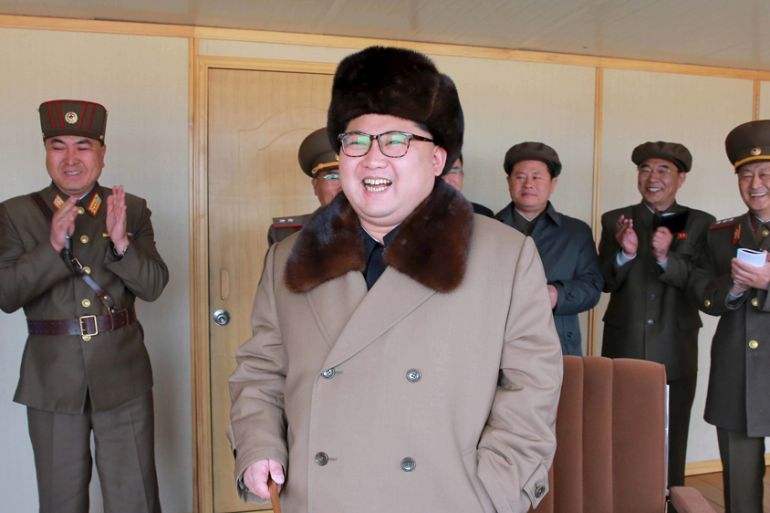North Korea ‘tests new ballistic missile engine’
High-powered engine successfully tested, increasing the range of North Korea’s nuclear missiles, Pyongyang says.

North Korea says it has carried out successful ground tests of a new engine for its intercontinental ballistic missiles.
The jet test of a new type of high-power engine was ordered and carried out at an unspecified date by leader Kim Jong-un, North Korea’s Korean Central News Agency reported, according to South Korea’s Yonhap news agency.
The test’s success “provided a firm guarantee for mounting another form of nuclear attack upon the US imperialists and other hostile forces”, Kim was quoted as saying.

Now North Korea “can tip the new type of inter-continental ballistic rockets with more powerful nuclear warheads and keep any cesspool of evils in the earth, including the US mainland, within our striking range”.
A video released on Saturday showed Kim supervising a missile test and military drills but it did not specify the dates.
The test was said to have been conducted at the missile station near North Korea’s west coast, Yonhap reported.
The isolated country has nuclear bombs and ballistic missiles, but there have been doubts that the bombs are light enough or the missiles powerful enough for a viable nuclear warhead.
South Korea said that the North is years away from developing such long-range ballistic missiles.
Kim in March said North Korea had developed a smaller warhead to fit on the intercontinental missiles, repeating a statement from a government representative last year.
North Korea held its fourth nuclear test explosion in January, and launched a long-range rocket in February, prompting the UN Security Council to impose its strictest sanctions ever on Pyongyang.
Hidden state: Inside North Korea
In March, North Korea said it had tested a solid-fuel rocket engine, which would allow more frequent launches, according to a South Korean defence ministry spokesman.
Last month it also fired several short-range missiles into the sea, and threatened a pre-emptive nuclear strike in response to an annual US and South Korean military drill.
The recent announcements regarding the country’s nuclear weapons programme could be to boost Kim’s leaderhip before a rare meeting of North Korea’s ruling Workers’ Party in May, Yonhap said, citing unnamed analysts.
North Korea’s nuclear weapons programme in milestones
- October 9, 2006: North Korea carries out its first atomic test.
- October 14, 2006: The UN Security Council unanimously imposes commercial sanctions and bans North Korea from importing ballistic missile technology in response to its nuclear test.
- May 25, 2009: North Korea conducts its second atomic test.
- February 12, 2012: North Korea appears to carry out its third atomic test, according to seismic data. Pyongyang claims it used a miniaturised nuclear device, but no radiation was detected.
- January 6, 2016: North Korea claims it has successfully tested a hydrogen bomb, its fourth test of an atomic device, but Western experts doubted it had the power of a hydrogen nuclear explosion.
- February 7: North Korea launches a long-range rocket and puts Earth observation satellite Kwangmyongsong-4 into orbit, although US reports said it was not operating correctly. The rocket launch is seen as a test of nuclear-capable weaponry.
- March 2: UN imposes toughest sanctions yet on North Korea, including a complete ban on the sale of all conventional weapons and inspections of all North Korean cargo. In response to the sanctions and to US-South Korea joint military exercises, Pyongyang threatens nuclear war and fires a series of ballistic missiles.
- March 24: The regime says it has successfully tested a solid-fuel rocket engine, which observers say could make missile launches easier and more frequent.
- April 9: North Korean leader Kim Jong-un announces that recent tests of an improved jet engine were successful, improving the range of the country’s intercontinental ballistic missile nuclear deterrent.